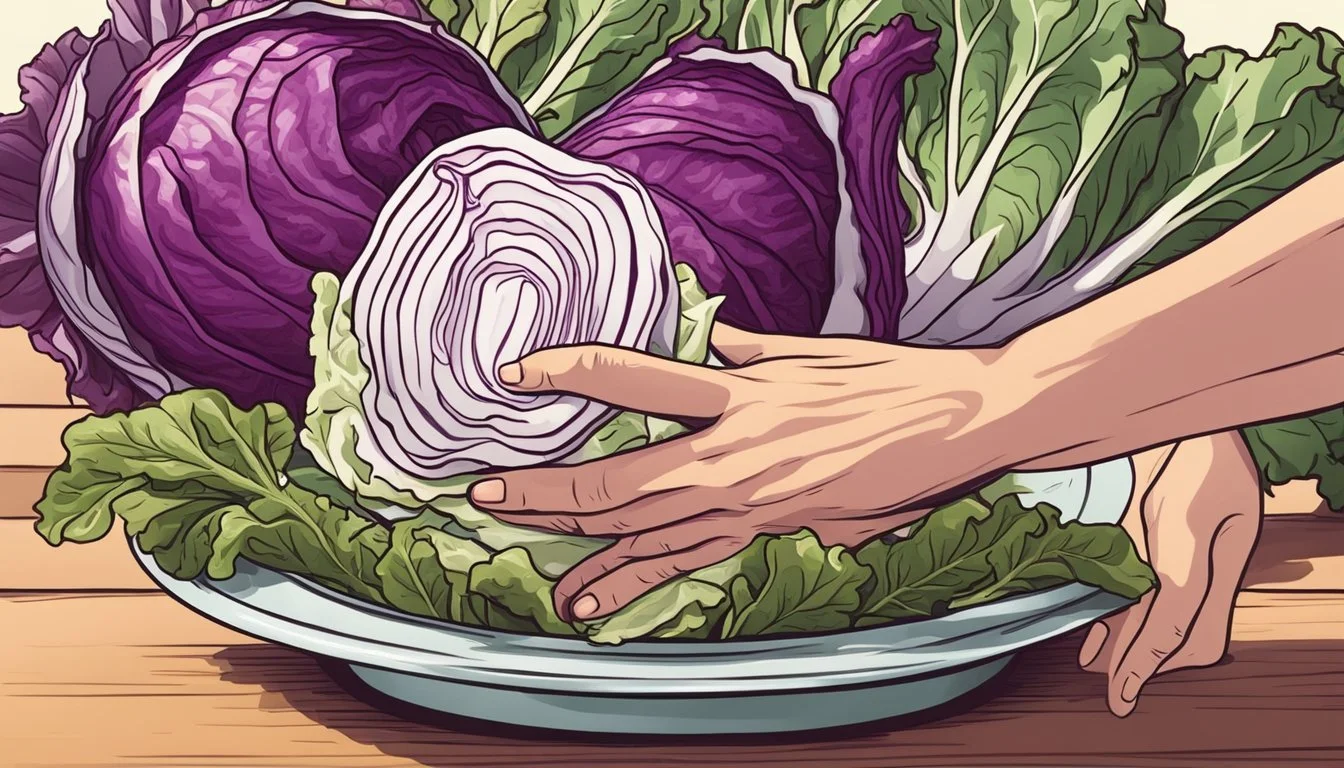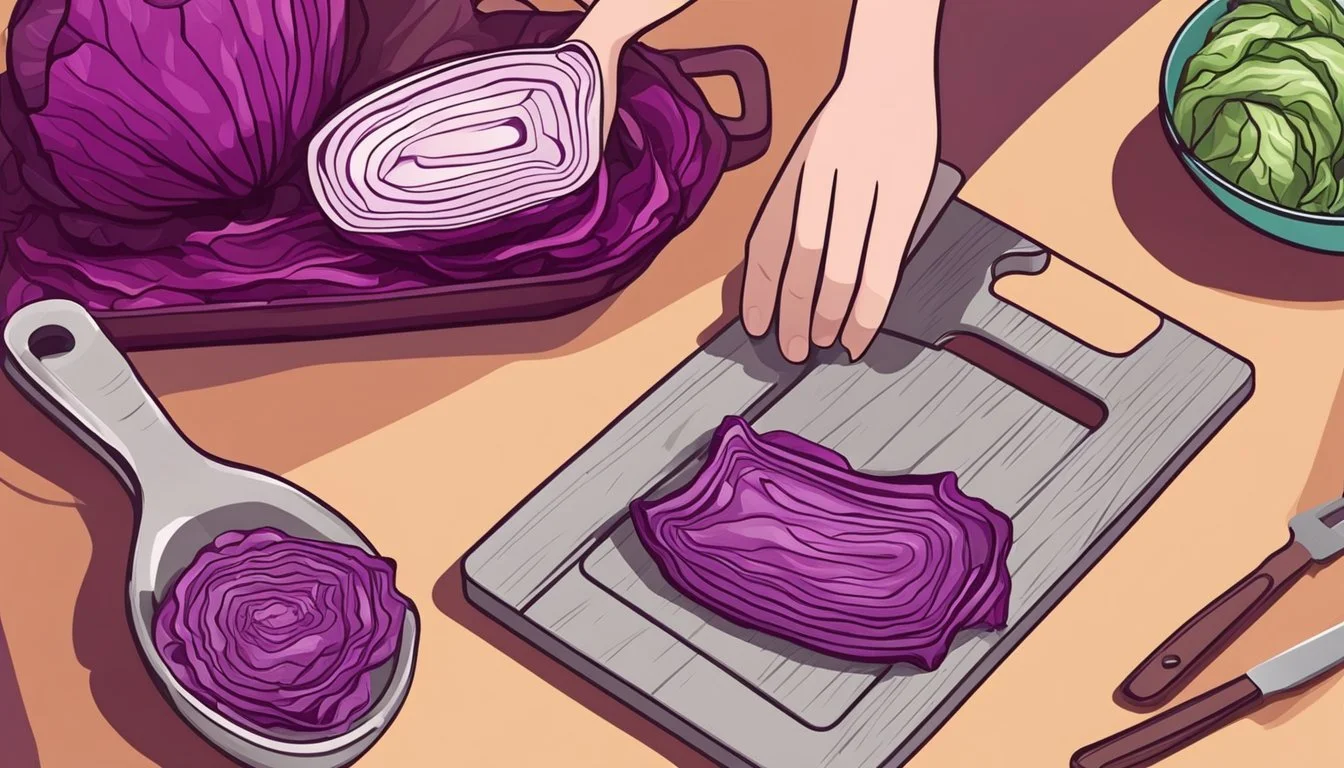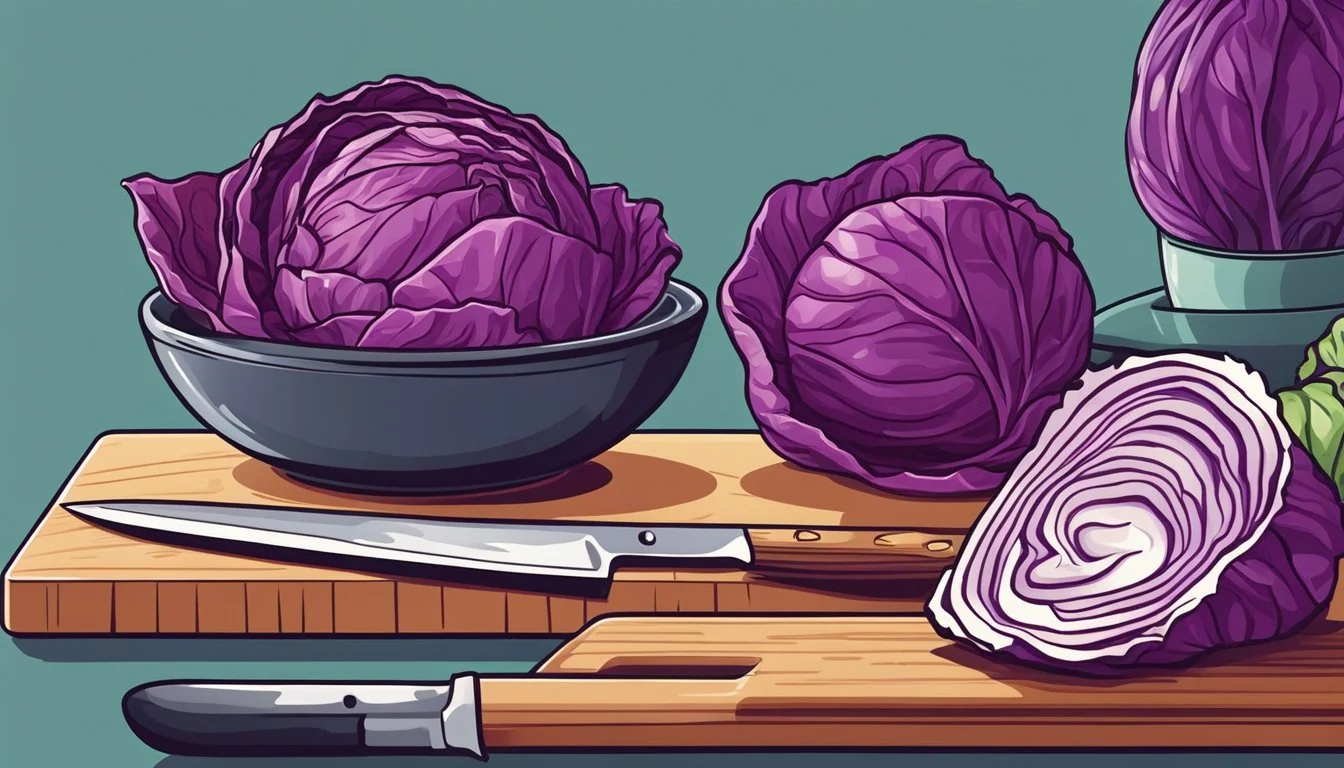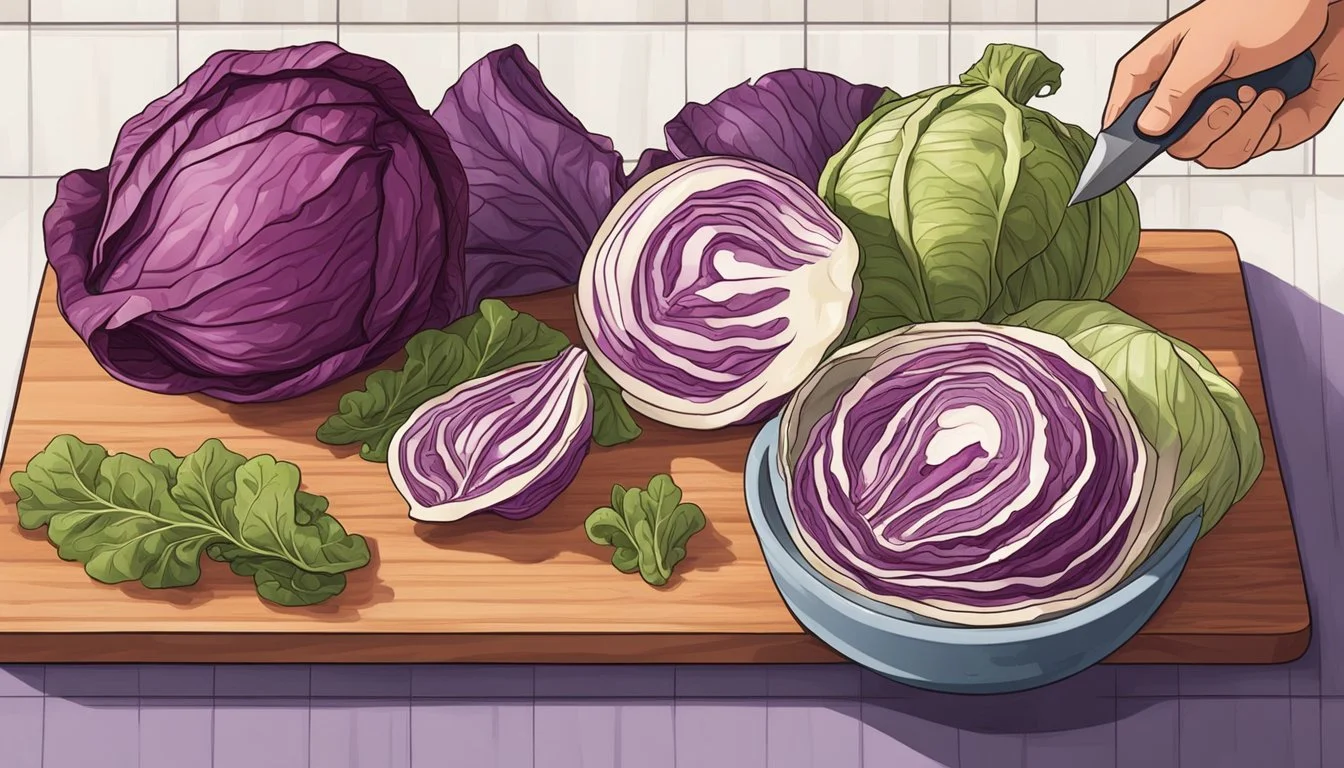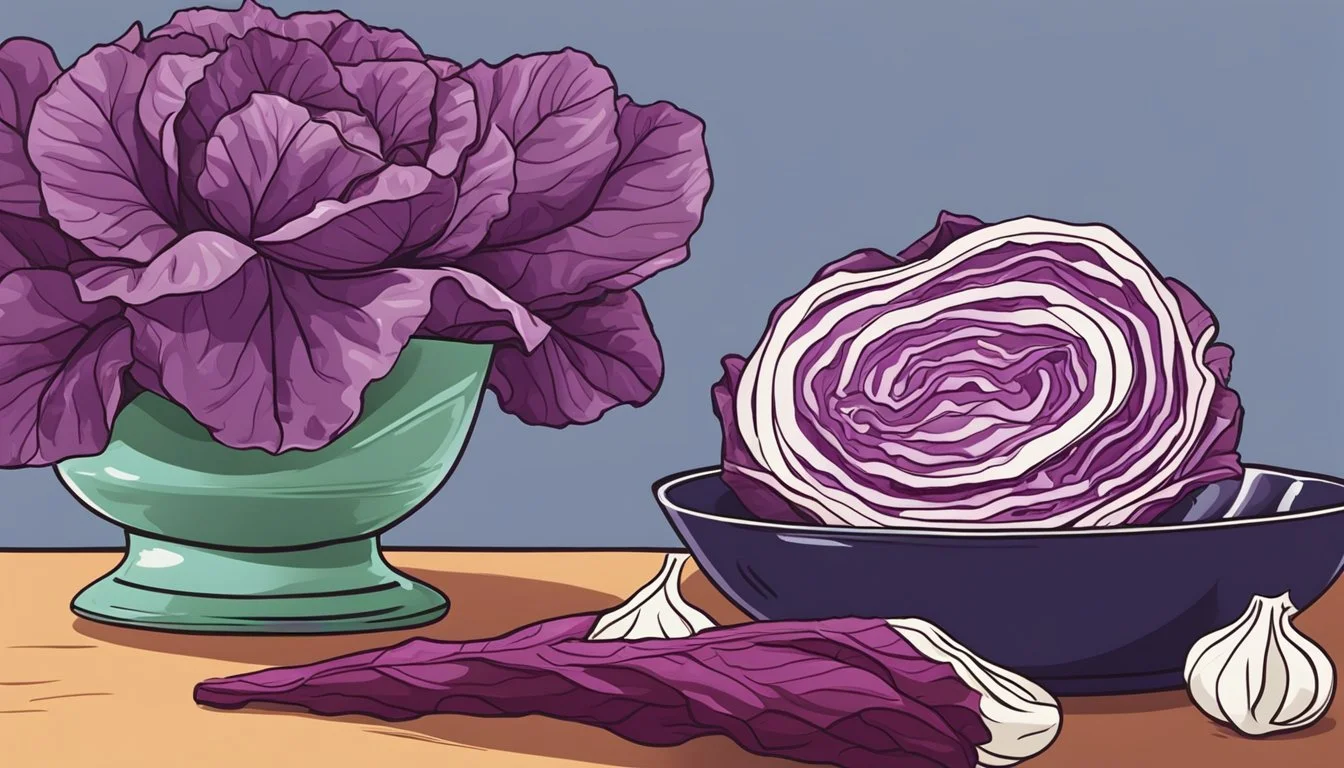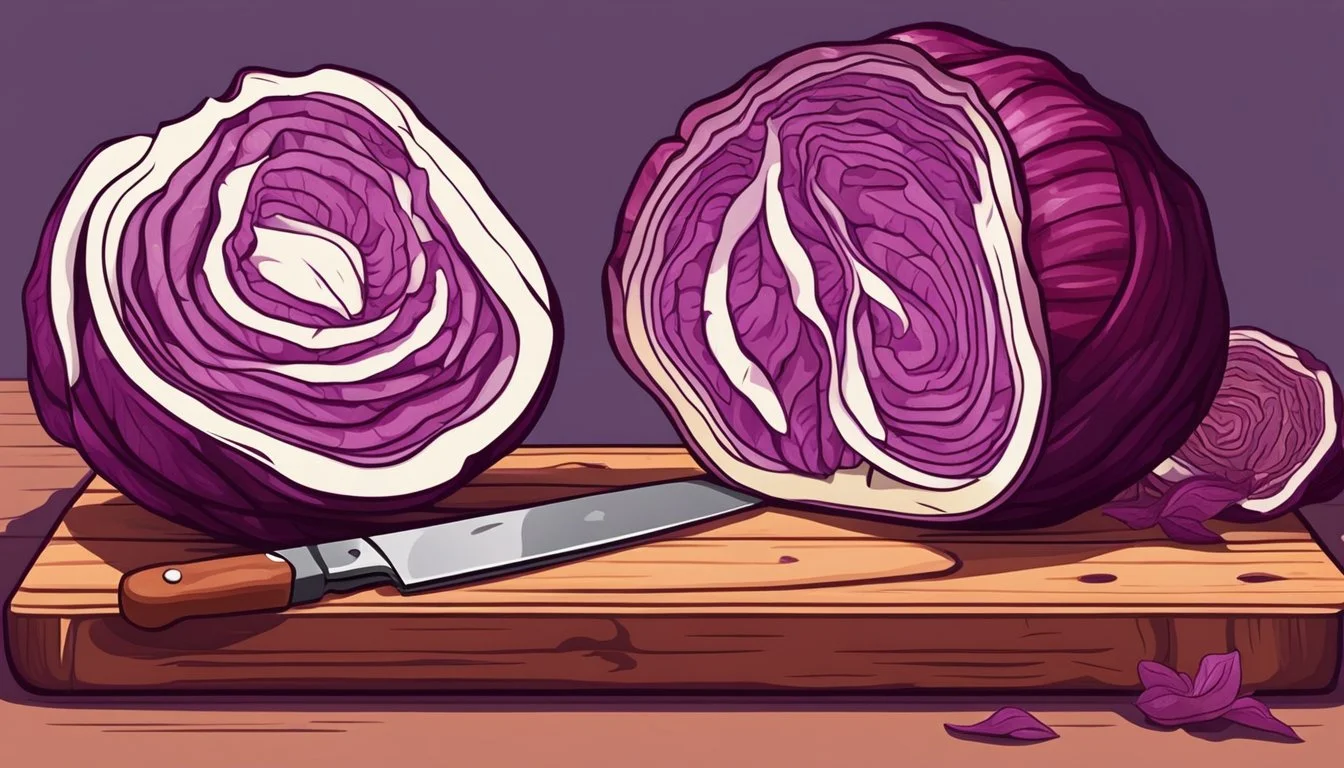How to Substitute Radicchio for Red Cabbage in Your Favorite Dishes
Radicchio, known for its striking maroon color and peppery bite, is often a key ingredient in salads (What wine goes well with salads?) and garnishes, adding both visual appeal and a unique depth of flavor. However, its less common presence in the everyday kitchen or a preference for a milder taste might necessitate a suitable replacement. In these instances, red cabbage emerges as an excellent alternative. Boasting a vibrant purple hue and a more subdued flavor profile, red cabbage can be utilized effectively to mirror the aesthetic qualities of radicchio while providing a gentle balance to dishes that might otherwise be overwhelmed by radicchio's intense bitterness.
When considering the substitution of radicchio with red cabbage, it is worth noting the textural distinctions alongside taste. Radicchio, typically smaller and more tender, differs from the firm and dense leaves of red cabbage. This difference becomes particularly important in raw preparations where the chewiness of red cabbage could be a stark contrast to the delicate crispness one expects from radicchio. However, red cabbage's robust structure makes it exceptionally well-suited to various cooking methods which can soften its texture. With careful preparation, such as thin slicing and perhaps a brief marination to tenderize, red cabbage can stand in for radicchio in a wide array of recipes, offering a similar crunch and visual allure.
Moreover, when used as a substitute, red cabbage provides an added nutritional benefit. Rich in vitamins and minerals, it can contribute to a well-rounded diet much like radicchio. Both vegetables share high levels of health-promoting compounds and can be interchanged without significantly altering the nutritional content of the dish. The key to a successful substitution lies in understanding the culinary framework of the recipe at hand, ensuring that the milder, sweeter notes of red cabbage are complementary to the intended flavor palette.
Understanding Radicchio
Radicchio is renowned for its unique bitter taste and striking appearance, often used to add a splash of color and complexity to various dishes.
Characteristics of Radicchio
Radicchio, known scientifically as Cichorium intybus, is a member of the chicory family. It's distinguished by its vibrant red leaves with contrasting white veins, delivering a bold, bitter flavor. This bitterness primarily comes from the presence of intybine, a compound found in the chicory family. The texture of radicchio leaves is firm and crisp, providing a satisfying crunch when bitten into.
Radicchio Varieties
Several varieties of radicchio are cultivated, with the most prominent ones hailing from different regions in Italy. The two main types are:
Chioggia: Spherical in shape, resembling a small cabbage, and is the most common variety found in supermarkets.
Treviso: Resembles a large Belgian endive, with elongated leaves and a milder taste compared to Chioggia.
Nutritional Profile of Radicchio
Radicchio boasts a remarkable nutritional profile, rich in dietary fiber, vitamins, and minerals. Here is a brief overview:
Fiber: Essential for digestive health
Vitamins: High in vitamin K, which is crucial for bone health, and vitamin C, known for its antioxidant properties and support in brain health.
Minerals: Contains a range of minerals essential for bodily functions.
Antioxidants: Rich in anthocyanins, the pigments that give radicchio its red color and offer health benefits potentially reducing the risk of heart disease.
Additionally, radicchio contains folate, which is important for cell function and tissue growth. This unique blend of nutrients makes radicchio not just a flavorful addition to meals but also a component of a healthy diet.
Similarities and Differences
When substituting radicchio for red cabbage, it's important to understand how both are similar in their roles as leafy vegetables and how they differ in characteristics such as flavor, texture, and color.
Red Cabbage Vs. Radicchio
Red cabbage, a member of the Brassicaceae family, and radicchio, part of the Asteraceae family, share some similarities. Both are categorized as leafy vegetables and possess a vibrant red color which can add a visually appealing element to dishes. However, they are distinct in their botanical classifications with red cabbage being part of the Oleracea species, while radicchio falls under the Chicorium genus.
Botanical Classification:
Red Cabbage: Brassicaceae family, Oleracea species
Radicchio: Asteraceae family, Chicorium genus
Flavor and Texture Considerations
Radicchio is known for its bitter taste and crisp texture, which can be likened to endive or escarole, and is often favored in salads. Red cabbage, in contrast, has a milder flavor with a slightly sweet note and a texture that can withstand longer cooking times, making it suitable for both raw and cooked applications like coleslaws and braised dishes.
Flavor Profile:
Red Cabbage: Milder, slightly sweet
Radicchio: Bitter and crisp
Texture:
Red Cabbage: Firm, holds well when cooked
Radicchio: Delicate, best used fresh in salads
Color and Presentation
The color of red cabbage ranges from a deep purple to a pale yellow hue near its core, and it tends to have a longer shelf life. Radicchio typically showcases a more vibrant red color with white veins and has a radiance that can diminish more quickly. When substituting one for another, the difference in color intensity should be considered as it could impact the visual outcome of the dish.
Color Variation:
Red Cabbage: Deep purple to pale yellow
Radicchio: Vibrant red with white veins
Culinary Applications
Red cabbage can be utilized as a Radicchio substitute in various dishes due to its similar crunchy texture and vibrant color. It can provide a unique twist to traditional preparations where Radicchio is usually employed.
Salad Preparations
In salad applications, red cabbage offers a sturdy, slightly sweet, and earthy taste that pairs well with a diverse range of dressings and ingredients. A red cabbage salad might include ingredients like sliced apples, walnuts, feta cheese, and a dressing made with balsamic vinegar and honey, offering a balance to the cabbage's natural bitterness. For a more traditional approach, shredding red cabbage for coleslaw gives a textural contrast when combined with a creamy dressing.
Cooking with Radicchio
When cooking, one might sauté red cabbage with garlic and olive oil for a side dish that complements richer main courses. The red cabbage can be braised gently in a combination of butter, apple cider, and honey—this method not only softens the cabbage but also mellows its flavor profile, making it an excellent side for robust meats.
Radicchio in Italian Cuisine
The use of red cabbage as a substitute for Radicchio in Italian cuisine requires consideration of Radicchio's bitter and peppery flavor. Red cabbage can be incorporated into pasta dishes, where it imparts a mild sweetness and a pop of color. Moreover, it can be added to a risotto, providing a crunch against the creaminess of the rice. Although traditionally Radicchio is found atop pizza or within a pasta, red cabbage can offer a different dimension of flavor when combined with traditional Italian ingredients like mozzarella and tomato sauce.
Common Substitutions
Radicchio, known for its bold color and bitter taste, can be replaced by a variety of leafy vegetables, each offering distinct flavors and textures suitable for different recipes. Substitutes can provide similar taste profiles or offer a contrasting culinary experience.
Radicchio Substitute Options
Endive: Resembling radicchio's texture, endive can be a suitable substitute, delivering a slightly milder bitter taste.
Curly Endive (Frisée): A member of the chicory family, its frilly leaves add a complex texture and a zestier bitterness than radicchio.
Arugula (Rocket): With its peppery and slightly tart flavor, arugula brings a distinct punch to dishes, making it an ideal replacement for radicchio's spiciness.
Watercress: As an aquatic plant, watercress offers a peppery taste similar to arugula, suitable for salads and sandwiches.
Chicory: Closely related to radicchio, chicory provides a similar bitterness and is often used in cooked applications.
Romaine Lettuce: While less bitter, romaine offers a crisp texture and can be grilled to bring out a charred flavor.
Belgian Endive: Its mild bitterness and firm texture make it a good stand-in, especially for presentation.
Treviso: A type of radicchio itself, Treviso has a similar bitter taste and can often be used interchangeably.
Escarole: Offers full leaves with a less pronounced bitterness compared to radicchio.
Dandelion Greens: While quite bitter, they add a unique punch of flavor to meals.
Radish: Sliced thinly, radishes can impart a spicy bite to salads where radicchio is typically used.
Mustard Greens: With a sharp and spicy flavor, these greens can be used to add heat to a dish.
Red Leaf Lettuce: Although not as bitter, it provides a pop of color akin to radicchio.
Kale: A hardy vegetable with a range of varieties, some of which may impart a more pronounced bitterness.
How to Choose a Substitute
When selecting a substitute for radicchio, consider the following:
Flavor Profile: Look for a similar bitterness or a complementary flavor that suits the recipe, such as the tartness of arugula or the spicy undertones of mustard greens.
Texture: Choose an option that mimics radicchio's crunch, like Belgian endive, or opt for something softer like curly endive, if preferred.
Recipe Adaptation: Decide if the substitute will be eaten raw, like in salads where freshness is key, or cooked, such as when grilling romaine lettuce.
Nutrient Content: If dietary nutrients are a consideration, compare the substitutes' profiles, as greens like kale and watercress are rich in vitamins.
Availability and Seasonality: Ensure the choice is readily accessible and in season for peak flavor and freshness, like choosing Treviso in winter or arugula in spring.
Recipe Adjustments
When substituting radicchio with red cabbage, chefs need to consider the flavor profiles of both vegetables. Red cabbage is milder and less bitter, requiring adjustments to achieve a similar taste to radicchio.
Adjusting for Bitterness
To mimic the bitter taste of radicchio, one might add a small quantity of a bitter ingredient, such as a dash of taramira oil, which should be used sparingly due to its potent flavor. Alternatively, a light sprinkle of a sharp, firm cheese like pecorino or blue cheese can infuse the bitterness that radicchio typically brings to a dish.
Table: Bitterness Adjustment Ingredients
Ingredient Quantity Notes Taramira Oil Start with 1/4 teaspoon Mix well and taste; adjust as necessary. Pecorino Cheese Grate approximately 1 tablespoon Add to hot dishes to allow for melting. Blue Cheese Crumble a small amount Use as a garnish or in salads.
Balancing with Other Ingredients
The sweetness of red cabbage might require balance with acidic ingredients or spices to achieve a depth of flavor akin to radicchio. Enhance the dish with additions like balsamic vinegar or lemon juice. Adding garlic or spicy elements can further sharpen the profile. If preparing a tomato sauce, consider simmering it with a halved garlic clove and removing it before serving, or incorporate a touch of spice to counteract the sweetness of tomatoes and the cabbage.
List: Ingredient Suggestions
Acidic ingredients: Balsamic vinegar or lemon juice (add to taste).
Garlic: Simmer in sauce; remove before serving.
Spices: A pinch of red pepper flakes or freshly ground black pepper for heat.
Tomatoes: Use less than when cooking with radicchio to prevent sweetness from overpowering the dish.
Preparation Techniques
When substituting radicchio with red cabbage, one must pay attention to the preparation methods to maintain both the dish's integrity and its visual appeal.
Proper Cleaning and Cutting
Red cabbage should be thoroughly rinsed under cold running water to remove any dirt or debris. Prior to cutting, the cabbage needs to be dried to ensure a crisp texture. The outermost leaves are typically removed, and the cabbage is then quartered. To match the fine, thin, and curly aspects of radicchio, red cabbage should be sliced into fine shreds using a sharp knife or a mandoline slicer. This ensures an even cooking or raw presentation in your dish.
Cooking Methods for Substitutes
The versatility of red cabbage makes it an excellent stand-in for radicchio in various cooking methods. Here are some recommended techniques:
Grilling: One can lightly brush the cabbage with olive oil and grill it until charred edges appear, simulating the texture and smokiness that grilled radicchio would have provided.
Sautéing: For a softer texture analogous to sautéed radicchio, red cabbage can be sautéed over medium heat. It may take a slightly longer cook time due to its denser leaves.
Baking and Roasting: Red cabbage can be baked or roasted to draw out its natural sweetness, offering a gentle contrast to the bitter notes of radicchio. When roasting, it is typically cut into wedges and seasoned before placing in the oven.
Italicize key actions, like slice, grill, sauté, bake, and roast to clearly indicate the specific preparation steps. These methods ensure your substitute not only fits the profile of radicchio's flavor but also its textural characteristics and role in the dish it accompanies.
Additional Tips
When substituting radicchio for red cabbage, one must take into account both the preservation of freshness and the optimization of nutritional value. These additional tips will guide the reader in achieving the best results from the substitution.
How to Extend Shelf Life
Radicchio can maintain its freshness and shelf life for up to two weeks if stored correctly. To achieve this, individuals should:
Wrap the radicchio head in a damp paper towel to maintain moisture, then place it in a plastic bag in the refrigerator's crisper drawer.
Avoid washing radicchio until it's ready for use, as excess moisture will accelerate spoilage.
Enhancing the Nutritional Benefits
Radicchio is low in calories and a good source of antioxidants, which may help in reducing inflammation. To bolster its nutritional benefits, consider:
Incorporating foods high in vitamin C, such as citrus fruits, to increase the absorption of iron from the radicchio.
For those seeking an antioxidant-rich diet, consume radicchio raw in salads, which preserves its nutrients better than cooking.
FAQs about Radicchio and Substitutes
Q: What is radicchio?
A: Radicchio is a leafy vegetable with a bitter taste and a vibrant red color, commonly used in Italian cuisine and salads.
Q: Why substitute radicchio in recipes?
A: One might need to substitute radicchio due to its availability, cost, or to modify the bitterness it imparts to dishes.
Q: Can red cabbage be used as a substitute for radicchio?
A: Yes, red cabbage is a suitable substitute, providing a similar crunch and color with less bitterness.
Q: How does red cabbage compare to radicchio in terms of taste?
A: Red cabbage has a milder flavor and less bitterness, making it a good alternative for those who prefer a subtler taste profile in their salads or French recipes.
Q: What should one consider when substituting red cabbage for radicchio?
Use a 1:1 ratio for substitution.
Red cabbage may alter the flavor profile slightly, being less bitter.
Cooking times are similar, making it an easy swap in recipes.
Q: Are there any nutritional differences between radicchio and red cabbage?
A: Both are nutritionally rich, with red cabbage having high levels of vitamins C and K.
Q: Can red cabbage replace radicchio in raw dishes?
A: Absolutely. Red cabbage works well in raw preparations like salads, offering a vibrant color and a crunchy texture.
Conclusion
In culinary practice, red cabbage stands as a commendable substitute for radicchio. While radicchio is known for its bitter taste and smaller, delicate leaves, red cabbage offers a milder flavor and crunchier texture. Those valuing healthy eating might note that both vegetables are nutrient-dense, though with distinct flavor profiles.
For salads, chefs often utilize red cabbage to introduce not only a colorful contrast but a textural difference as well. It may be finely sliced or chopped to resemble the consistency of radicchio, although the taste will be less intense.
When considering cooking applications, red cabbage is versatile, working well in both raw and cooked dishes. Its durability under heat also makes it suitable for various preparations that might turn radicchio too wilted. The culinary wisdom suggests to balance the sweetness of red cabbage with acidic components such as vinegar or lemon juice when aiming to mimic the sharper bite of radicchio.
The comparison table below elucidates the key distinctions and relevant considerations:
Aspect Radicchio Red Cabbage Flavor Bitter Mild, sweet Texture Delicate Crunchy Nutritional Value Rich in vitamins and minerals Rich in vitamins and minerals Culinary Uses Best raw in salads Versatile, suitable for raw/cooked dishes
In essence, swapping these two in recipes requires attention to their unique characteristics. Nevertheless, chefs can achieve a harmonious blend of taste and nutrition using either one, adhering to a philosophy that champions innovative, healthy, and flavorful eating.

